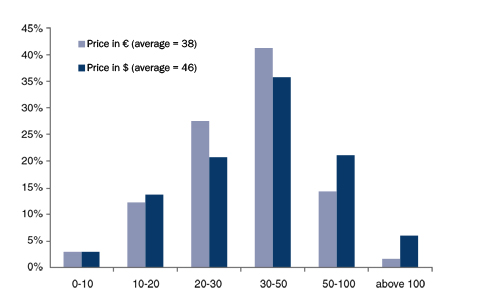MAIN PUBLICATION :
| Home � ENVIRONMENT � Policy measures to combat... � Carbon as a commodity |

|
CARBON AS A COMMODITY
The Kyoto Protocol's efforts to mitigate climate change have resulted in an international carbon market that has grown tremendously since the entry into force of the Protocol in 2005. While previously, the relatively small market consisted mostly of pilot programmes either operated by the private sector or by international financial institutions such as the World Bank, it has experienced strong growth in the past two years, and was valued at €40 billion in 2007, 80 per cent more than the 2006 value. The total traded volume increased by 64 per cent from 1.6 MtCO2 in 2006 to 2.7 Mt in 2007 (Figure 3.1).
Figure 3.1: Annual Contract Volumes 2005-2008

Source: Point Carbon (2008)
While the international carbon market has expanded to include a wide variety of project types and market participants, it has been dominated by two market-based mechanisms: the EU ETS and the CDM.
The EU ETS continues to be the largest carbon market, with a traded volume of 1.6 MtCO2 and a value of €28 billion in 2007 (Point Carbon, 2008), which corresponds to nearly a doubling of both volume and value compared to the previous year. The EU ETS now contains more than 60 per cent of the physical global carbon market and 70 per cent of the financial market. The CDM market increased to 947 MtCO2 equivalents and €12 billion in 2007. This is an increase of 68 per cent in volume terms and a staggering 200 per cent in value terms from 2006, and the CDM now constitutes 35 per cent of the physical market and 29 per cent of the financial market. The JI market, while still small, also finally started to take off in 2007, nearly doubling in volume to 38 MtCO2, and more than tripling in value to €326m.
However, experts predict that the potential for future market growth is much larger. Point Carbon forecasts 56 per cent market growth in 2008, increasing volumes to over 4 million tonnes of carbon, with a value of more than €60 billion, depending on prices. Current prices in the ETS hover around €25/tonne, and CDM prices range from anywhere between 9 and 17/tonne, depending on the type of project and its stage of development.
Providing that the price for carbon is high enough, the carbon market is a powerful tool for attracting investment, fostering cooperation between countries, companies and individuals, and stimulating innovation and carbon abatement worldwide. In theory, at least, the price of carbon should more or less directly reflect the rigorousness of the economy-wide caps of the Annex B countries. The reality is of course more complicated, since there is only one real 'compliance market' at present, which is the EU ETS, and the CDM and JI markets are in reality just getting started. It is also not clear what role Canada, Japan and Australia will play in the carbon market during the first commitment period; and of course, the original conception and design of the carbon market was predicated on the fact that the US would be a large buyer, which has not turned out to be the case, again, for the first commitment period. Governments negotiating the post-2012 climate agreement seem committed to 'building carbon markets' and/or 'keeping the CDM', but there is very little detail to go on at present. The UNFCCC negotiations in June 2008 produced little more than a shopping list of issues to be addressed in the further development of carbon markets in general and the CDM in particular.
Point Carbon conducted a survey of carbon market practitioners at the end of 2007 and came up with the figures presented in Figure 3.2. These give a good prognostication as any as to the future price of carbon.
Figure 3.2: What will be the Cost of Carbon in 2020? (Currency of Choice. N=2591 (2157 Responses in EUR; 967 in USD)

(Source: Point Carbon, 2008)
>> Wind energy's contribution to emissions reduction
| Acknowledgements | Sitemap | Partners | Disclaimer | Contact | ||
|
coordinated by  |
supported by  |
The sole responsibility for the content of this webpage lies with the authors. It does not necessarily reflect the opinion of the European Communities. The European Commission is not responsible for any use that maybe made of the information contained therein. |
